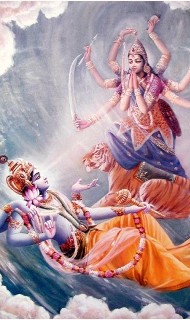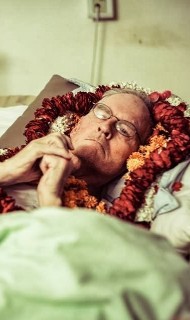 By Giriraja Swami
By Giriraja Swami After hearing so many complaints from so many devotees, Srila Prabhupada called a meeting of all the devotees. Practically all the devotees in the temple came into Srila Prabhupada’s room, and he listened very sympathetically to what every devotee had to say, and he was really concerned and wanted to improve things. At one stage the GBC for India protested: “Srila Prabhupada, my only intention was to execute Your Divine Grace’s will.” And Prabhupada replied a little sarcastically, “Is it My Divine Grace’s will that the devotees should be disturbed?” And he made a system. He named certain leaders—Tamal Krishna, Yamuna, me—and said that they should get together every week and discuss the problems, and whatever they decided they should write down in a minute book, and they should all sign and then do what they agreed. Continue reading "Everything for Krishna and nothing for me
→ Dandavats"

 By HH Bhakti Bhringa Govinda Swami
By HH Bhakti Bhringa Govinda Swami  Tapahpunja Dasa: Once upon a time, in a village called New Vrindaban, a group of young villagers experienced how service to the cows, coupled with worship of Sri Sri Radha Vrindaban Chandra, defined their daily routine and consecrated their love for Srila Prabhupada’s first farm mission.
Tapahpunja Dasa: Once upon a time, in a village called New Vrindaban, a group of young villagers experienced how service to the cows, coupled with worship of Sri Sri Radha Vrindaban Chandra, defined their daily routine and consecrated their love for Srila Prabhupada’s first farm mission. By Purushottam Nitai Das
By Purushottam Nitai Das
















 ISKCON Gangtok: The mercy of Sri Sri Nitai Gaurchandra has reached the farthest corner of north-east India, border of india and china.
ISKCON Gangtok: The mercy of Sri Sri Nitai Gaurchandra has reached the farthest corner of north-east India, border of india and china.

 When Srila Prabhupada first arrived at the Paris temple, the devotees anxiously waited on a veranda high above the front entrance. Like demigods, they showered flower petals onto His Divine Grace. Srila Prabhupada responded with a beautiful smile, reciprocating the love and affection his disciples exhibited.
When Srila Prabhupada first arrived at the Paris temple, the devotees anxiously waited on a veranda high above the front entrance. Like demigods, they showered flower petals onto His Divine Grace. Srila Prabhupada responded with a beautiful smile, reciprocating the love and affection his disciples exhibited.

 By His Divine Grace A.C.B. Swami Prabhupada
By His Divine Grace A.C.B. Swami Prabhupada By Yogesvara dasa
By Yogesvara dasa  By Dayananda das
By Dayananda das




 By Hari-dhama dasa
By Hari-dhama dasa
